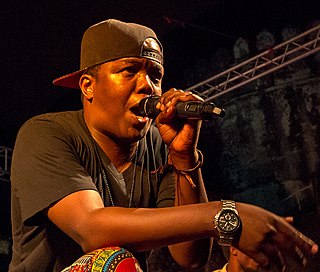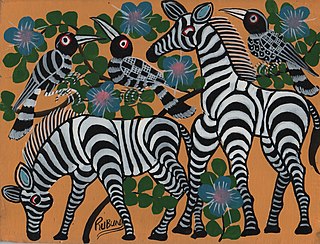Related Research Articles

Mtwara Region is one of Tanzania's 31 administrative regions, with its capital as the municipality of Mtwara. Mtwara Region is home to one of the most infuluential people in Tanzania, the Makonde. Mtwara is home to Tanzania's 4th president Benjamin Mkapa and is home to a number of influential artists. The boundary with Mozambique to the south is formed by the Ruvuma River. To the west, Mtwara is bordered by Ruvuma Region, to the north by Lindi Region, and to the east is the Indian Ocean.

The Makonde are an ethnic group in southeast Tanzania, northern Mozambique, and Kenya. The Makonde developed their culture on the Mueda Plateau in Mozambique. At present they live throughout Tanzania and Mozambique, and have a small presence in Kenya. The Makonde population in Tanzania was estimated in 2001 to be 1,140,000, and the 1997 census in Mozambique put the Makonde population in that country at 233,358, for an estimated total of 1,373,358. The ethnic group is roughly divided by the Ruvuma River; members of the group in Tanzania are referred to as the Makonde, and those in Mozambique as the Maconde. The two groups have developed separate languages over time but share a common origin and culture.

Following Tanganyika's independence (1961) and unification with Zanzibar (1964), leading to the formation of the state of Tanzania, President Julius Nyerere emphasised a need to construct a national identity for the citizens of the new country. To achieve this, Nyerere provided what has been regarded by some commentators as one of the most successful cases of ethnic repression and identity transformation in Africa.

George Lilanga was a Tanzanian painter and sculptor, active from the late 1970s and until the early 21st century. He belonged to the Makonde people and lived most of his life in Dar es Salaam, the largest city in Tanzania.

Ambwene Allen Yessayah, better known by his stage name A.Y., is a Tanzanian bongo flava artist of Makonde heritage. He was born in Mtwara, Mtwara Region, Tanzania. He began his career with the group S.O.G. in 1996. He decided to go solo in 2002. A.Y. is among the first bongo flava artists to commercialize hip hop. He was member of the musical group known as East Coast Army, but now he is no longer part of the group. He is still releasing songs and albums collaborating mostly with a former East Coast Army artist Mwana Fa.
Makonde, or Kimakonde, is the language spoken by the Makonde, an ethnic group in southeast Tanzania and northern Mozambique. Makonde is a central Bantu language closely related to Yao. The Matambwe (Matembwe) and Mabiha (Maviha) dialects are divergent, and may not be Makonde.

Tingatinga is a painting style that originated in East Africa. Tingatinga is one of the most widely represented forms of tourist-oriented paintings in Tanzania, Kenya and neighbouring countries. The genre is named after its founder, Tanzanian painter Edward Tingatinga. Tinga Tinga also insipired kids animation tales, namely Tinga Tinga Tales.
Edward Saidi Tingatinga (1932–1972) was a Tanzanian painter, best known as the founder of the eponymous painting style and school.

The Afrika-Haus Freiberg is a museum of modern African art at Freiberg am Neckar in Germany.
The name Makonde art refers to East African sculptures or, less frequently, to modern paintings created by craftspeople or artists belonging to the Makonde people of northern Mozambique and southern Tanzania, separated by the Ruvuma river. Art historians, dealers and collectors have created this genre of African art, that can be subdivided into African traditional artifacts or modern artistic works. This genre can be traced back to the 1930s, when the first documented exhibition of Makonde art was held at the Centro Cultural dos Novos in the former Portuguese colony of today's Mozambique.
Simon George Mpata (1942–1984) was a Tanzanian painter of the Tingatinga school. He was the youngest half-brother of Edward Tingatinga, founder of the school, and belonged to the restricted group of six students that were directly taught by Tingatinga himself. Among Tingatinga's students, Mpata is considered the most faithful to his teacher's style. Upon Edward Tingatinga's death, Mpata left Tanzania, moving to Nairobi, where he established his own studio. Mpata's art has received international acclaim, mostly thanks to Japanese magazine editor Kazumi Oguro, who was impressed by Mpata's art while visiting Kenya and later organized an exposition in New York and popularized Mpata's art in Japan.

Ali Saleh Kiba, best known as Alikiba or occasionally as King Kiba, is a Tanzanian musician and songwriter. He is one of the most talented musicians in East Africa and mostly considered the King of Bongo Flava music Genre. He is from Kigoma and the owner of both Kings Music label and Crown Media Group. With hit songs such as Mwana, Aje, Chekecha Cheketua, Cinderella, Nakshi Mrembo, Usiniseme, Dushelele, Single Boy with Lady Jaydee, Mapenzi Yana Run Dunia, mahaba, mama with legendary yvone chaka chaka and Macmuga. Ali Kiba is usually regarded as one of the most successful Bongo Flava stars usually associated with his close rival Diamond Platnumz.